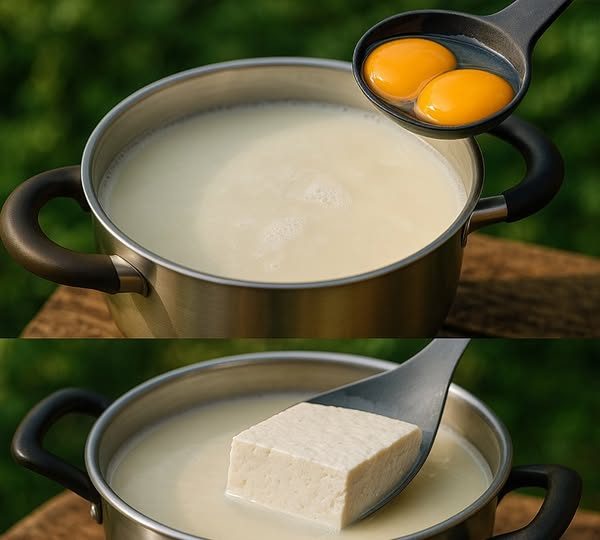Here’s a refined and engaging version of your guide for boiling eggs, tailored to keep readers interested while ensuring clarity:
🥚 Mastering Perfect Boiled Eggs: The Foolproof Method for Soft, Medium, or Hard-Boiled Eggs
Boiling eggs seems simple enough, but getting them just right—whether soft-boiled with a runny center or hard-boiled with a firm yolk—can be tricky. The key lies in understanding the nuances of water temperature, timing, and cooling methods.
If you’ve ever struggled with stubborn shells, overcooked yolks, or rubbery whites, this guide will ensure you achieve perfectly boiled eggs every time.
🔬 Why Most People Get Boiled Eggs Wrong
A common mistake in egg boiling is immediately plunging hot eggs into cold water. While this seems like a quick cooling trick, it causes thermal shock, which makes the egg whites contract and the shell stick. The result? Cracked eggs and frustrating peeling.
Recent culinary research shows that a gradual cooling process—starting with warm water—is much gentler and helps eggs peel effortlessly. The way you cool your eggs is just as important as the way you cook them.
🧪 The Science of Boiling Eggs Perfectly
When you boil an egg, proteins in the white (albumen) start firming up between 140°F to 160°F (60°C to 71°C), while the yolk sets at 149°F to 158°F (65°C to 70°C). If you cook too quickly or unevenly, you risk overcooking and tough textures.
In addition, the calcium and magnesium in the eggshells react to temperature changes, influencing the texture and ease of peeling. Managing heat and cooling carefully ensures your eggs have a smooth texture and peel cleanly.
🛠️ Ingredients & Tools You’ll Need
Ingredients:
- 4–6 large eggs (1–2 weeks old for best peelability)
- Room-temperature water (enough to cover eggs by at least 1 inch)
- Optional: 1 teaspoon salt or vinegar (helps prevent cracking)
Tools:
- Medium saucepan with a lid
- Timer or phone stopwatch
- Slotted spoon or tongs
- Bowl for cooling water
📋 Step-by-Step Guide: How to Boil Eggs the Right Way
Step 1: Prep the Eggs
Start with eggs that are about 7–10 days old. These are easier to peel because their pH level changes over time, creating a slight gap between the white and the shell.
Place your eggs in a single layer at the bottom of the pot to avoid cracking and ensure even cooking.
Step 2: Add Water & Optional Ingredients
Cover the eggs with room-temperature water, ensuring they are submerged by at least an inch. You can also add 1 teaspoon of salt or vinegar to prevent cracking and stabilize the whites during cooking.
Step 3: Bring to a Gentle Boil
Place the pot over medium heat. Avoid high heat to prevent eggs from bouncing around and cracking. Allow the water to slowly reach a gentle, rolling boil.
Once boiling, start your timer based on your desired doneness:
- Soft-boiled eggs: 4–6 minutes (runny yolk)
- Medium-boiled eggs: 7–9 minutes (creamy but set center)
- Hard-boiled eggs: 10–12 minutes (firm yolk with no dark ring)
Step 4: Controlled Cooling
After cooking, remove the pot from the heat. Instead of immediately dumping the eggs into ice water (which can lead to tough shells), transfer them to warm water for 1–2 minutes to gently stop the cooking.
Next, move the eggs to room-temperature water and let them sit for 5–10 minutes to cool gradually. This method results in smoother peeling.
Step 5: Peel With Ease
To peel, gently tap each egg on a flat surface and roll it under your palm. Start peeling from the wider end (where there’s usually an air pocket) and do so under running water to help lift stubborn bits of shell and membrane.
🔑 Tips for Perfect Boiled Eggs
- Use a Timer: Always use a timer to prevent overcooking. Overcooked eggs can develop a sulfuric smell and a green ring around the yolk.
- Room-Temperature Eggs: Take eggs out of the fridge 30 minutes before boiling. This ensures even cooking and reduces the risk of cracking.
- Skip the Ice: Ice water can cause shells to stick. Gradual cooling works best for peelability.
- Choose Quality Eggs: Organic or free-range eggs often have richer yolks and firmer whites. They not only taste better but also peel more easily.
⚠️ Safety Tips
- Freshness Check: Test your eggs by placing them in water. If they float, they may be spoiled. Fresh eggs will sink and lie flat.
- Don’t Overcook: Overcooked eggs can have a rubbery texture and an unpleasant odor.
- Handle with Care: Always handle eggs gently to avoid cracking, which can lead to bacterial contamination.
🧑🍳 Why This Method Works—Backed by Science
Culinary research confirms that using a slow heating and cooling method leads to more consistent textures and easier peeling. This approach minimizes protein contraction, maintains yolk integrity, and ensures a smooth peel by preserving the shell membrane.
🎯 Master Boiled Eggs for Any Occasion
Whether you’re preparing breakfast, making deviled eggs, or prepping a protein-packed snack, mastering the art of perfectly boiled eggs makes all the difference. With the right timing, water temperature, and cooling method, you’ll never struggle with stubborn shells again.
Start warm, heat gently, cool gradually, and peel with ease. It’s a small effort that guarantees flawless boiled eggs every time.
